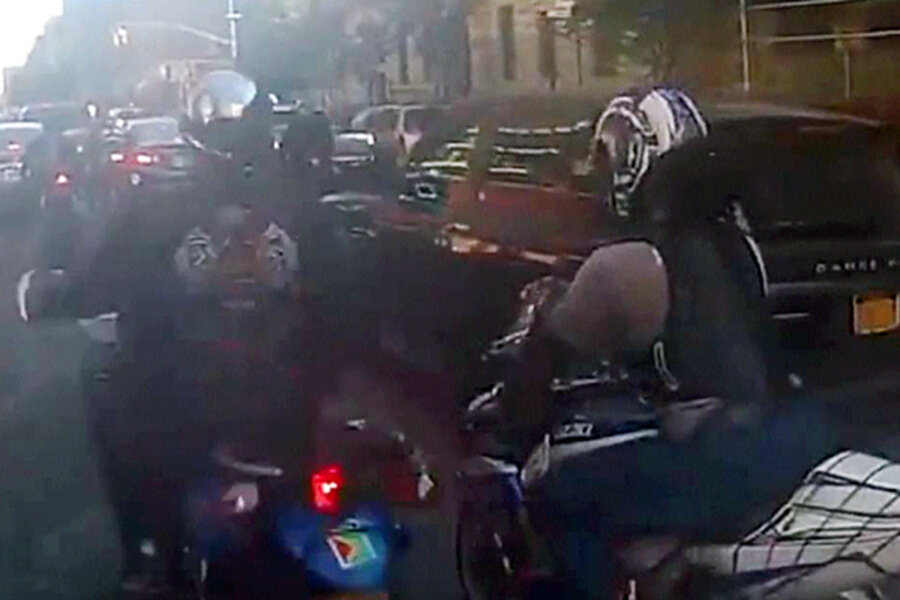New York biker attack's 'Mad Max' antics spook public, bring harsh charges
Loading...
| Atlanta
The gripping helmet-cam video depicting bikers chasing down a suburban family in an SUV is like a “Mad Max” flashback: ruthlessness mixed with glee, and an apparent embrace of lawlessness by even an undercover police officer who, according to prosecutors, joined in to “terrorize” a motorist and his family, including a two-year-old child.
Some commentators have linked the daring group attack on the family in the SUV – it took place Sept. 29th on the Upper West Side – to a broader “mood of civic abandonment” in the country, “an ominous broad-daylight instance of lawlessness, of the kind that can become symbolic of an era,” as Nick Paumgarten writes this week in the New Yorker.
Manhattan prosecutors, meanwhile, surprised some observers by leveling more-serious-than-expected felony charges against at least six of the bikers, including an undercover NYPD police detective, Wojciech Braszczok, who turned himself in late Tuesday after a video showed him pounding on the rear of the SUV.
Mr. Braszczok was stripped of his badge before being charged Wednesday with first-degree gang assault, first-degree assault, and third-degree criminal mischief for “terrorizing” the family, even though the video of the attack does not show him laying hands on anyone.
As many as 1,000 bikers were taking part in a raucous ride in the city that day. The confrontation began when the SUV driver, Alexian Lien, bumped a motorcycle that had moved in front of him. Motorcyclists then swarmed Mr. Lien’s car angrily, and Lien hit several of them as he tried to flee, running over and badly injuring one of them. Dozens of motorists looked on in horror as the bikers chased, cornered, and finally stopped the SUV, pulling Lien out and beating him before his terrified wife and daughter.
The charges against Braszczok, especially, suggested that prosecutors have a lot at stake and are under heavy public pressure to make sure the bikers are punished.
“The reason we focus so much attention on this case is it makes everybody feel vulnerable, and that’s why there’s so much pressure on the prosecutors,” says Jack Levin, a criminologist at Northeastern University, in Boston. “You’ve got a sense that anybody could be next, surrounded by a large number of bikers in broad daylight – it inflames public perception because it seems like a major threat to public safety.”
The attack has certainly struck a nerve among Americans, already beset in the last two weeks with chaotic images from the fatal shooting of an apparently distraught woman who led police on a high-speed chase toward Capitol Hill, a man who died after setting himself on fire on the Washington Mall, and a lingering government shutdown that has highlighted and exacerbated a deep and cynical polarization in the country.
Against that backdrop, the biker attack on the SUV raised questions about who was really in the wrong: The driver who may have invited harassment and ended up seriously injuring one of the bikers, or the gang who felt free and justified to apparently impart street justice on a regular American family?
Lawyers for one of the bikers charged with assault said his client was simply trying to talk to Lien about what happened. But the video also shows bikers working together to cut off escape routes as the situation steadily escalated into violence. When the car was finally stopped, and while dozens of people in traffic made 911 calls, Lien was pulled from his car and beaten unconscious. Lien has not been charged.
To be sure, in Braszczok’s case, undercover police officers aren’t always required to stop a crime in progress since that could blow their cover. But prosecutors said the officer had no right to “terrorize the rest of the family on the other side of the vehicle” while Lien was being beaten.
The officer’s attorney says the video of the event will exonerate his client, who claims the window on the passenger side was already broken, and that he never got close to the driver during the beat-down.
For prosecutors trying to unravel exactly what did happen, and who should be punished, they are dealing with not just a public sense of vulnerability about being similarly victimized, but also an unresolved sense that the attack says something about deeper changes in American culture.
“I think there is a longer-term trend where we’re seeing increasing incivility and lawlessness in places where we never expected them to be,” argues Northeastern’s Mr. Levin.






